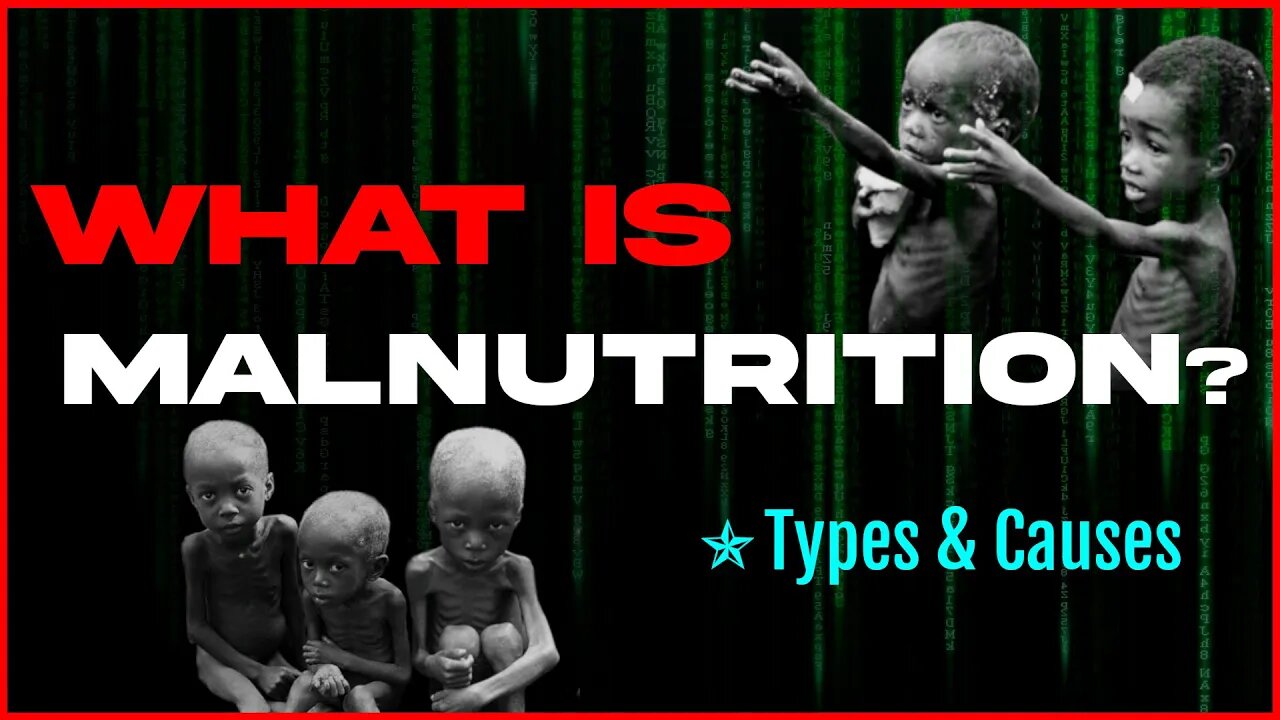Premium Only Content

What is Malnutrition? Types & Causes
https://www.msf.or.jp/publication/pressreport/pdf/pressMalnutritionE.pdf
--- A Beginner’s Guide to Malnutrition ---
--- What Is Malnutrition? ---
On average, the human body needs more than 2,100 kilocalories per day to lead a normal, healthy life.
Adequate nutrition is essential for the physical development and maintenance of the body as well as resistance to disease, ability to learn and energy to work.
Malnutrition is defined as an imbalance between the body’s supply of nutrients and the body’s demand for growth, maintenance and specific activities.
When a person cannot take in sufficient nutrients to meet their needs, the body begins to waste away.
First they lose fat, and then muscle.
Malnutrition is not measured by how much food is eaten, but by physical measurements such as weight and height.
Malnutrition in children is often measured by comparing their weight measurement with what would be expected for someone their height.
Once a child has fallen below 80% of the weight that is average for their height they are defined as “acutely malnourished”.
Swellings on both feet, known as ‘bilateral oedema’, are also a sure symptom of malnourishment in children.
If children are under-nourished over a long period of time, their growth may be stunted.
This is known as chronic malnutrition.
If they experience rapid weight loss – or ‘wasting’ – over a short period of time, they are described as suffering from acute malnutrition.
Even if people have sufficient quantities of food to eat, they can become malnourished if their food does not provide the right amount macro-nutrients (proteins, fats and sugars) and micro-nutrients (vitamins and minerals).
In other words, malnourishment is to do with the quality as well as the quantity of food.
Malnutrition and disease can interact in a vicious cycle.
Inadequate food intake results in the body being increasingly sensitive to infections.
Infections often lead to poor appetite and nausea - resulting in reduced food intake - and can also impair the body’s ability to absorb nutrients.
In turn, malnutrition weakens the immune system and increases the incidence, severity and duration of infections.
This dangerous cycle can ultimately lead to death.
--- Types of Malnutrition ---
- Macro-nutrient deficiency
The most common form of malnutrition, called marasmus, occurs when an individual is unable to take in a sufficient quantity of food in general.
Children with marasmus are severely wasted, with no fat and very little muscle tissue left on their body.
They often appear old and shrivelled and have prominent ribs and limb joints.
They are left with almost no subcutaneous fat and their internal organs, including the heart and the blood, are weakened.
With no reserves to fight infection, illnesses such as pneumonia, diarrhea, and measles can be fatal.
The second common type of malnutrition in children is kwashiorkor, which is specifically caused by a lack of protein-energy and certain micro-nutrients in the diet.
Symptoms of kwashiorkor include a swollen abdomen, severe anemia and ‘oedema’ – swellings of the feet, legs and arms which can make up 30% of a child’s body weight.
Another distinctive symptom is hair turning red and falling out.
Like marasmus, kwashiorkor kills by lowering resistance to infection.
However, it can also be fatal in its own right, because it disturbs levels of salts and minerals in the body.
- Micro-nutrient deficiency
Vitamin A deficiency weakens the immune systems of a large proportion of under-fives in poor countries, increasing their vulnerability to diseases such as diarrhea, measles and malaria.
Lack of vitamin A can also lead to eye diseases and eventually blindness.
Iodine is necessary for the thyroid to function normally and for development of the nervous system during the first trimester of pregnancy.
Iodine deficiency results in goitre and ‘cretinism’, associated with severe mental retardation and physical stunting.
Vitamin B1 deficiency can lead to beriberi.
There are several different types of the disease, which can affect the nervous system and heart and cause gastrointestinal problems.
It often occurs when white rice is the staple food in a population’s diet.
Lack of vitamin C can lead to scurvy.
It mainly occurs when people have little access to fresh fruit and vegetables.
Vitamin B3 deficiency leads to pellagra, which is indicated by diarrhea, dementia and skin lesions (often around the neck).
Feed The Starving Children Organization
https://www.feedstarvingchildren.org/
-How YOU can send food directly to a Orphanage:
Easy 1-2-3 Step System:
1) Find a Orphanage in a poor part of the world.
2) Find a Local Grocery Store or Food Wholesaler that can deliver to the orphanage.
3) Place the order & have it delivered!
-
 4:45:15
4:45:15
RalliedLIVE
7 hours ago $1.60 earnedWarzone Domination w/ Ral
47.1K -
 1:10:17
1:10:17
Sarah Westall
8 hours agoWorld Leaders Increasingly Display Panic Behavior as Economic Change Accelerates w/ Andy Schectman
72.7K15 -
 59:54
59:54
Motherland Casino
5 hours ago $1.55 earnedScar x Ayanna
27.9K5 -
 41:57
41:57
BonginoReport
11 hours agoProtecting Kids From WOKE Ideology in School (Ep. 35) - Nightly Scroll with Hayley Caronia -04/25/25
118K50 -
 LIVE
LIVE
SpartakusLIVE
8 hours agoFriday Night HYPE w/ #1 All-American Solo NUKE Hero
141 watching -
 1:15:07
1:15:07
Kim Iversen
1 day agoThe Left Is Dead — What And Who Will Rise From the Ashes?
103K79 -
 2:06:17
2:06:17
Joker Effect
6 hours agoYOU DON'T UNDERSTAND FREEDOM OF SPEECH IF THIS MAKES YOU MAD!
14.6K1 -
 1:45:26
1:45:26
vivafrei
12 hours agoSantos Sentenced to 87 MONTHS! Corrupt Judges ARRESTED! Some Canada Stuff & MORE!
144K95 -
 4:34:03
4:34:03
Nerdrotic
12 hours ago $31.98 earnedStar Wars GRAPED? Hollywood In Freefall, Silver Surfer is a MAN! | Friday Night Tights 351
102K27 -
 1:33:35
1:33:35
Keepslidin
8 hours ago $1.03 earned$5000 START | ROAD TO 100K | Mother.land
30.5K2